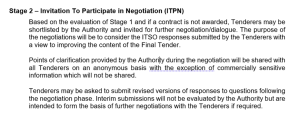Table of Contents
Article Details
Post tender negotiations are a mechanism contracting authorities can use as part of the tender process, particularly under the ‘competitive flexible’ procedure.
Once your bid has been submitted, the last thing you may expect is a call to revisit the tender process in the form of post tender negotiations. Whilst contracting authorities are not permitted to alter, amend or renegotiate contracts after they have been awarded, they may invite bidder organisations to further discussions or potential adaptations to your final submission.
We explain what post tender negotiations may look like, why they are used and what you can expect when you receive this after submitting your bid.
Post tender negotiations explained
Simply put, post tender negotiations involve a dialogue between the contracting authority and bidder(s) regarding their tender submission. Some potential topics of a post tender negotiation could include:
- Pricing aspects of the bid or invitations to price additional elements – broadly speaking, this is the most common reason for a post tender negotiation
- Future service delivery plans addressed in the quality aspect of the tender, particularly if there is conflicting or vague information around a certain topic
- Social value initiatives included as part of the submission, verifying these are a contractual commitment and clarifying any initiatives which may be unclear
- Separate responses to different questions in the form of an interview, presentation or scenario-based exercise, as an additional step of the tender process.
Post tender negotiations could also take the form of a post-tender clarification message, only necessitating a very brief response.
Why are post tender negotiations used?
Ultimately, post tender negotiations ensure that the buyer and suppliers awarded the contract have the same understanding of the contract specification, terms and conditions and agreed deliverables.
Reading between the lines, the authority may be choosing between submissions of a similar quality, and a post tender negotiation offers the opportunity to make a final selection. In other instances, there may simply be an unclear element of your submission which the evaluator wants to seek clarity around.
Post tender negotiations are often called for where the buyer is not overwhelmed by the proposals of their bidders or bidder. For example, there may only be one potential bidder who is effectively naming their price, and the buyer may not feel this is a viable value for money solution.
Regardless, post tender negotiations present a good opportunity for suppliers (although the initial feeling may not be as positive) to clarify their existing offering – further assuring the buyer you are ideally positioned to deliver the contract or framework agreement.
How to approach post tender negotiations
- Read the invitation or message carefully: similarly to a quality question or method statement, make sure you are answering the question the authority is asking, rather than the question you would like to be asked.
- Qualify your response: if required, you can provide rationale for why your submission has included a particular element. For example, if you get a clarification regarding an approach to your service delivery, you can substantiate your position by providing an example of where you have done this in the past, with successful results.
- Respond promptly: a request for further information or negotiation may occur soon after the tender has been submitted, and may also be time-bound (e.g. two working days to respond).
- Be honest: the authority is not trying to trick you into giving the wrong response. Provide your answer and rationale clearly and concisely, highlighting any potential added value or cost savings benefits which you can present alongside your submission.
Ultimately, it is important to remember that all of the above supports the contracting authority awarding the contract to the ‘most advantageous tender,’ thereby providing a value for money solution.
How the Procurement Act 2023 affects post-tender negotiations
As part of the new regime governing all public sector bids and tenders, the Procurement Act 2023 introduced a new tender procedure known as the ‘competitive flexible’ procedure. Per the guidance within Section 20 of the Act:
“… [a competitive flexible procedure is] any procedure such as the contracting authority considers appropriate for the purpose of awarding the public contract.”
As part of the provision for the competitive flexible procedure, buyers are allowed to design their own tender processes, which can include a separate negotiation stage, as outlined below:

Recent example of a post tender negotiation
Contracting authorities are starting to leverage this as part of their procurement activity. Given authorities have embraced different voluntary aspects of the Procurement Act thus far, it is reasonable to assume this may continue – underscoring the importance of ensuring familiarity with post tender negotiations.
Support with post tender negotiations
Our expert bid and tender writers can support with drafting responses to post tender clarifications as well as bid presentations for long-term, repeat clients. To find out more about the bid and tender services we provide and how we can support with any post tender activity which is related to the submission, contact us today at info@executivecompass.co.uk or via telephone 0800 612 5563.
